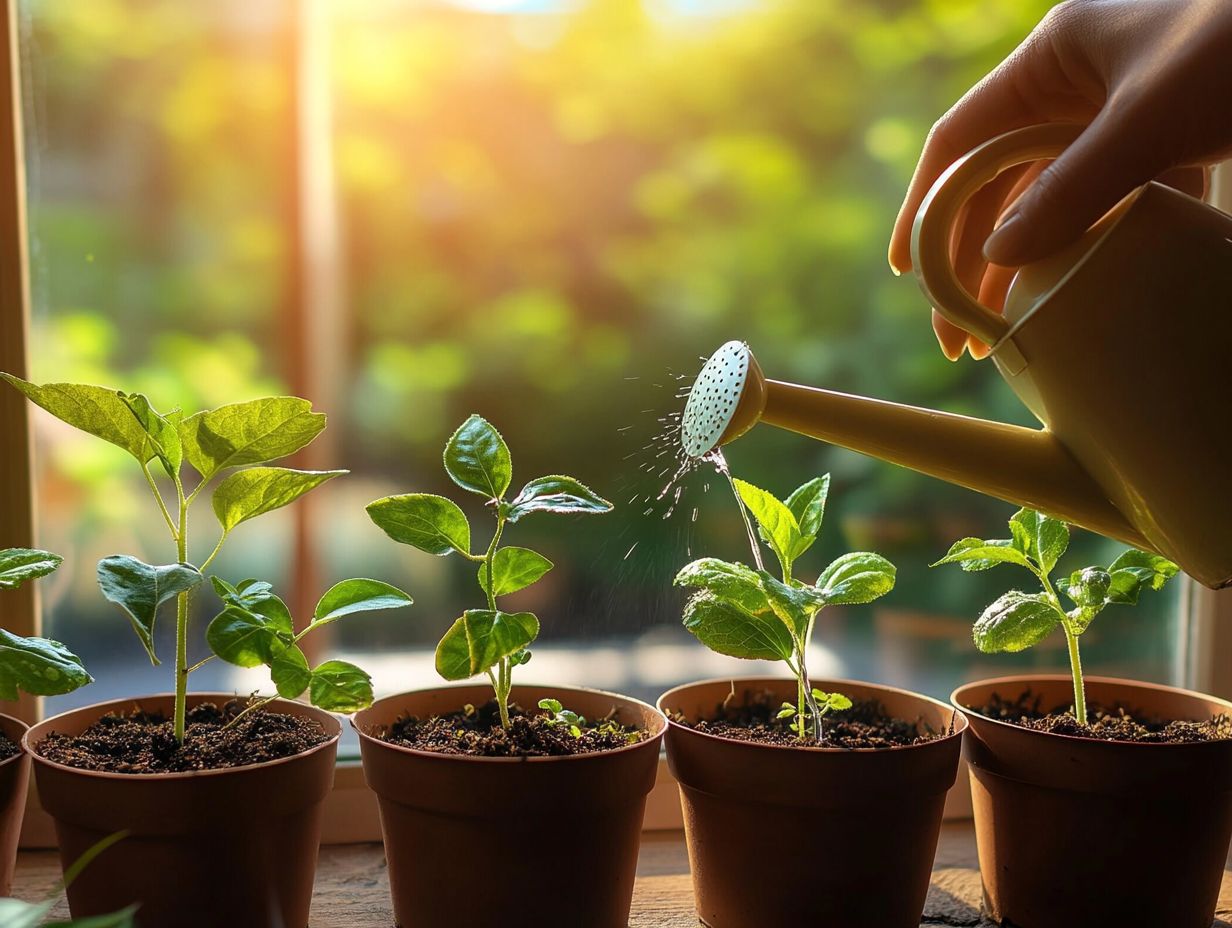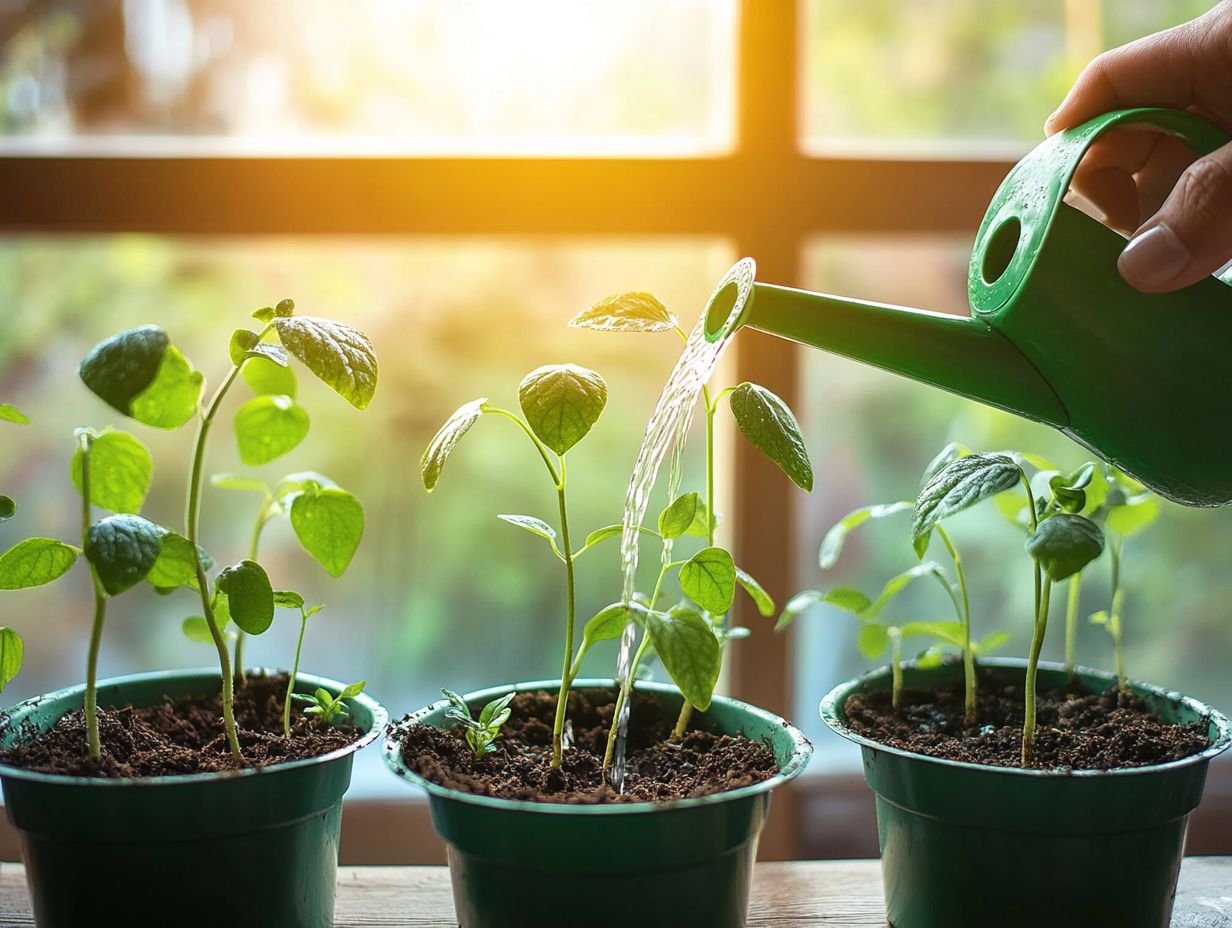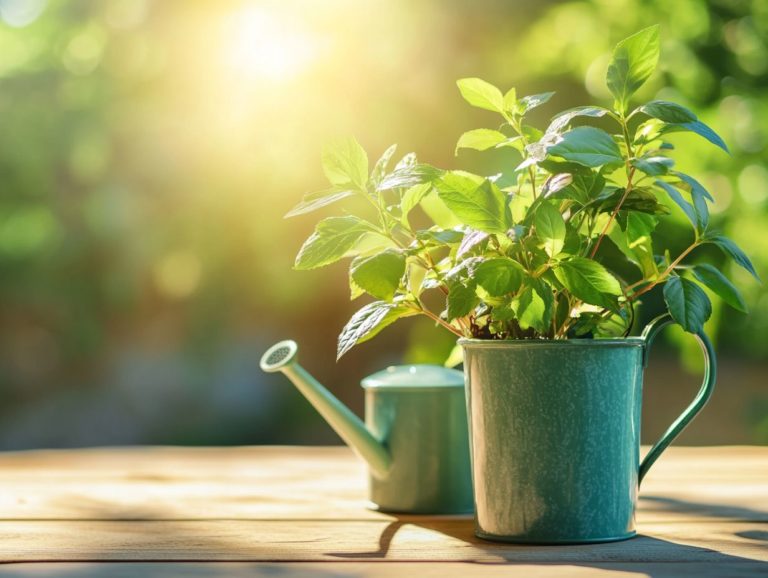How to Water Plant Cuttings Effectively
Water propagation is a fun and easy way to grow new plants, perfect for anyone eager to become a proud plant parent! This guide delves into the advantages of this gardening method, helping you choose the right water for your cuttings and providing detailed, step-by-step instructions for achieving successful propagation.
You ll also learn the optimal time to transition your flourishing cuttings to soil and how to troubleshoot common issues along the way. Uncover just how effortless it can be to propagate plants in water, especially with the right propagation tools!
Contents
Key Takeaways:

Understanding Water Propagation
Understanding water propagation is essential for garden enthusiasts. This gardening method involves placing leafy cuttings in fresh water, allowing roots to grow naturally.
It s an appealing approach for those new to gardening, as it simplifies the cutting process and reduces the risk of bacterial growth often associated with soil mixtures.
By creating the ideal conditions for water propagation think sunlight exposure and consistent watering you can effortlessly cultivate new plants and enhance your gardening skills from the ones you already have.
What is Water Propagation?
Water propagation is an elegant gardening technique where you place plant cuttings in water to promote roots growing before transitioning them to soil, making it a popular method for beginner gardeners.
This method involves submerging the cut end of a stem or leaf in clear water, creating a moisture-rich environment that allows roots to emerge and flourish. Unlike soil-based propagation, where cuttings must depend on the nutrients and water in the soil, water propagation offers immediate access to hydration and allows you to easily monitor root development.
This technique is particularly advantageous for plants like Pothos and ivy, which thrive in water and often exhibit quicker growth and more robust root systems, making them popular choices among gardening experts. It minimizes the risk of overwatering and encourages healthy root formation, making it a preferred strategy for both novice and seasoned gardeners alike.
Benefits of Water Propagation
Water propagation presents a wealth of advantages for gardeners, positioning it as a favored method among both novices and seasoned experts. This technique enables you to witness the growth of roots firsthand, instilling confidence that your cuttings are taking root successfully.
It also reduces stress on healthy cuttings, allowing them to flourish in nutrient-rich environments that closely resemble their natural habitats and promoting their initial growth.
Beyond its practical benefits, propagation jars can also elevate your indoor aesthetics, transforming your gardening journey into a visually pleasing experience.
Why Choose Water Propagation?
Choosing water propagation is a straightforward process that lets you visually monitor the root growth of your plant cuttings, ensuring they re on track to become healthy plants through effective plant care.
This method has gained popularity for its simplicity and transparency. With a clear view into the development of roots, you foster a deeper connection with your plants. By using water as your growing medium, you can easily determine when your cuttings are ready to transition to soil, paving the way for successful plant care.
The process is uncomplicated, making it an enabling choice for anyone who might feel daunted by traditional gardening techniques.
Ultimately, water propagation invites you, regardless of your experience level, to take an active role in nurturing your greenery. Dive into the world of water propagation and watch your garden thrive!
Choosing the Right Water for Plant Cuttings

Selecting the right water is key for propagating your plant cuttings successfully. The quality of water you choose significantly influences root development and the overall health of your plants. Making informed choices here can set the foundation for thriving growth and successful propagation.
Factors to Consider
Key factors include clean water, sunlight exposure, and temperature. These elements are vital for establishing strong roots and ensuring overall plant vitality.
Clean water is essential; it prevents harmful bacteria and contaminants from hindering growth and creates a sterile haven for delicate cuttings. Sunlight exposure is also important, as it fuels the process plants use to turn sunlight into energy, meeting the energy demands of developing roots. Maintaining an optimal temperature encourages cellular activity and growth, allowing your cuttings to transition into their new root systems efficiently.
By evaluating these factors, you can enhance your success in propagating plants and mastering the cutting technique.
Steps for Water Propagation
Successfully conducting water propagation requires following essential steps and utilizing effective propagation procedures. Start by preparing your cuttings with care, then establish a propagation station where you can implement optimal plant care tips.
This careful approach will ensure your efforts yield the best results.
Preparing the Cuttings
Preparing your cuttings properly is crucial for successful water propagation. Selecting healthy cuttings and determining the ideal cutting length can significantly influence root development.
Begin by choosing vigorous cuttings that are free from diseases or pests. Look for stems that are firm and plump, ideally taken from the new growth of the plant. A cutting length of about four to six inches is usually recommended, as this provides a substantial area for root development while maintaining energy for growth.
In some instances, using a substance that helps cuttings grow roots faster, such as Clonex, can enhance your chances of success by stimulating root formation. By following these practices, you’ll encourage robust roots and lay the groundwork for thriving, healthy plants in the long run.
Setting Up the Water Propagation Station
Setting up a water propagation station requires careful consideration of the container typically a glass jar and the ideal conditions for root growth.
Choosing the right jar can significantly impact the success of your plant cuttings; opt for clear glass to allow sunlight to penetrate, which is essential for photosynthesis. It s also important to place your propagation station in a location that receives bright, indirect sunlight, as direct exposure could scorch delicate leaves.
Maintaining optimal conditions involves more than just light; ensure the water remains clean and at room temperature, promoting healthy roots. Regularly changing the water prevents the buildup of bacteria, creating a nurturing environment for your cuttings as they embark on their growth journey.
Caring for the Cuttings During the Process

Caring for your cuttings during the water propagation process is essential. With consistent watering and proper monitoring, you can ensure the growth of healthy plants.
To thrive, these young plants require regular water changes to prevent stagnation and promote essential oxygenation. It s also crucial they get enough light, which stimulates photosynthesis and fosters robust development.
Diligent monitoring of root growth is vital; regularly check the roots for signs of health or decay to guide necessary adjustments to their care. By understanding and implementing these techniques, you can support your plants on their journey from mere cuttings to thriving, vibrant specimens.
Start your propagation journey today and watch your plants flourish!
Transferring Cuttings to Soil
Transferring cuttings to soil is an essential step in the water propagation process. This transition ensures that root establishment continues in a nutrient-rich environment. It promotes healthy growth and vitality as your cutting method matures.
When to Transfer and How to Do It
Knowing when to transfer cuttings and how to do it effectively is vital for your plant’s health during its transition to soil.
The best time to transfer is crucial. If you move cuttings too early, you risk shocking the young roots. Waiting too long could lead to overcrowding or stunted growth in your propagation jars. Observe the root clusters closely to determine their readiness for relocation.
Generally, you’ll want to move cuttings once they’ve developed a robust network of roots, typically around two to four inches in length. Ensure conditions like moisture and temperature are just right for a smoother transition into the planting medium. This careful approach highlights the importance of each step in the propagation process.
Troubleshooting Common Issues
Troubleshooting common issues in water propagation, such as root rot and other complications, is crucial for ensuring your plants thrive.
By effectively addressing these concerns, you can create a flourishing environment that promotes robust growth.
Dealing with Root Rot and Other Problems
Root rot can be quite a challenge in water propagation. Understanding its causes and implementing prevention strategies will help you maintain healthy cuttings.
Root rot mainly results from over-saturation and poor drainage, which foster fungal growth in waterlogged settings. Factors like inadequate air circulation, low light, and contaminated water can complicate matters, even affecting the hardiest plants.
To tackle this issue, regularly monitor water quality and ensure your cuttings are in clean, well-aerated containers. Incorporating beneficial microorganisms enhances your plant’s immune response, reducing the risk of root decay.
Adjusting the water level to just cover the roots while allowing ample air exposure is key for long-term success.
Frequently Asked Questions

How often should I water my plant cuttings?
The frequency of watering depends on the type of plant, its size, and environmental conditions. Generally, water your plant cuttings every 2-3 days, but check the soil moisture before watering again.
What is the best way to water plant cuttings?
The best way to water plant cuttings is by using a watering can or a spray bottle. This allows for gentle and even distribution of water, avoiding damage to the delicate cuttings.
Is it better to water from the top or bottom of the plant cuttings?
Water from the bottom of the plant cuttings, known as the “bottom watering” method. This allows the roots to soak up the water, promoting healthy root growth.
Should I use tap water or filtered water to water my plant cuttings?
Use filtered or distilled water for your plant cuttings. Tap water may contain chemicals and minerals that can harm the delicate cuttings.
How much water should I give my plant cuttings?
The amount of water needed varies based on the size and type of plant, as well as environmental factors. Give enough water to moisten the soil, but avoid making it waterlogged.
What should I do if my plant cuttings are wilting?
If your plant cuttings are wilting, it may indicate overwatering. Allow the soil to dry out slightly before watering again. Wilting can also signal underwatering, so check the soil’s moisture level before watering.
Take steps now to implement these tips and ensure your cuttings thrive! If you have any questions, feel free to reach out for more information.






